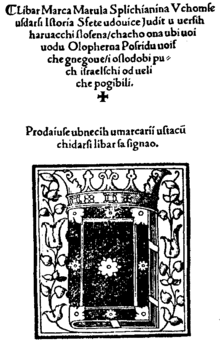Judita
 Cover of the first edition ofJudita | |
| Author | Marko Marulić |
|---|---|
| Language | Croatian |
| Subject | Story of Biblical Judith |
| Publisher | Guglielmo da Fontaneto |
Publication date | 13 August 1521 |
| Publication place | Croatia,Republic of Venice |
Judita(Judith) is one of the most importantCroatianliterary works, anepic poemwritten by the "father of Croatian literature"Marko Marulićin 1501.
Editions
[edit]The work was finished on April 22, 1501,[1]and was published three times during Marulić's lifetime. The first edition was arranged by Petar Srićić ofSplitand was printed in Venice by Guglielmo da Fontaneto on August 13, 1521, that is, 20 years after it was written. One extant copy of the first edition is held in theMala braćaFranciscan library inDubrovnik,and the other in theZadarfamily Paravia's library, which is today a part of the Scientific Library of Zadar.
The second edition was edited by Zadar librarian Jerolim Mirković, published on May 30, 1522, and is illustrated with nine woodcuts depicting war scenes. The ninth woodcut is signed with the letter M, and it was therefore assumed that Marulić himself was the author of the woodcuts. One copy of Mirković's edition was given to theUniversity LibrarybyIvan Kukuljević,and the other copy, still held in the Collection of Manuscripts and Old Books of the University Library, originates from the Kukuljević's legacy.
The third edition was printed on January 29, 1522, for the Dubrovnik librarian Jacomo di Negri. (Transposing the date fromVenetian calendar,the publication date would be January 29, 1523.) The only surviving copy of that edition is held at theBavarian State Libraryin Munich.
Theme and influence
[edit]The frequency of printing indicates that the text found its readership not only inSplit,which had at most 200 literate citizens at the time, but in otherDalmatiancentres. The poem contains 2126dodecasyllabiclines, with caesurae after the sixth syllable, composed in six books (libar). The linguistic basis of the book is SplitChakavianspeech and theShtokavianlexis, and theGlagoliticoriginal of the legend; the work thus foreshadows the unity of Croatian, as Marulić puts it himself on the cover "u uersih haruacchi slosena" / "in Croatian verses laid out".
Marulić'sJudithhas none of the decorative epithets typical of folk epics. The epic poem is also notable for the Humanistic treatment of the subject and the author'sPetrarchandescriptions of Judith's beauty.Judithis interesting as a cultural monument as well as for its composition. The author's choice of a subject that simultaneously deals with an act of heroism and a crime shows suggests he privileged the literary structure (plot, drama) of the material, and only then considered its moralistic overtones.
Thematically, theJuditadeals with the story of the widowJudithwho by her heroic act—the treason, seduction and the murder of Assyrian generalHolofernes—saves the city ofBethulia.It was no accident that Marulić chose the story of the Biblical Judith for literary treatment. His work stemmed in part from his desire to offer a literature to "even those who understand no scholarly books",[2]and the plot would seem to have contemporary parallels—a homeland invaded by foreigners, as the Balkans were being swept by the "eastern dragon" —theOttoman Turks.Insofar as the poem has political or moral weight,Judithis intended as an exemplar of confidence inGodand in eternal justice.
The plot
[edit]The first book
[edit]The first book describes the Babylonian rulerNebuchadnezzar II(who conquered Syria and Palestine), his slaying ofArpachshad,and his desire to rule the world. Nebuchadnezzar sends his general Holofernes to conquer as much land as he can, terrorizing the inhabitants.
The second book
[edit]Holofernes' military campaign, ranging across many lands, finally brings him to Israel. The people, in horror, pray to God for salvation.
The third book
[edit]Holofernes lays siege to Bethulia, cutting off the town's water supply. After much hardship, the leaders of the town decide to surrender, but Duke Ozias begs the Jews to be patient for five more days, to await God's salvation.
The fourth book
[edit]Judith, widow of Menasses, prays to the Lord and, along with Abra, her slave, flees the city that same night. God bestows upon her the gift of extraordinary beauty, which she will use to seduce Holofernes.
The fifth book
[edit]Holofernes invites Judith to dinner in his tent. On the fourth day of a festival, a drunken Holofernes falls asleep. Judith cuts off his head and mounts it on the city gates in view of his men. They flee in horror, and those who remain are easily driven off by the citizens.
The sixth book
[edit]The sixth book describes events in the Jerusalem after the departure of Holofernes' army. The High Priest Eliakim arrives with his priests to see Judith. She leaves for Jerusalem and returns after three months. She never remarries, and there is peace in the land as long as she lives. After her death she is mourned by the citizens for seven days.
Translations
[edit]Juditawas translated intostandard Croatianin the 20th century: in 1969,Ivan Slamnigpublished a prose translation of the first chapter, and in 1983,Marko Grčićpublished a book containing the entire translation with an inline comparison to the original text.Nikica Kolumbićpublished a lyrical translation of the first chapter in 1971, and completed the translation in 1985.[3]
Notes
[edit]- ^Judita:Posveta:"Od rojen'ja Isukarstova u puti godišće parvo nako(n) tisuća i pet sat, na dvadeset i dva dni miseca aprila. U Splitu gradu."
- ^"i onima, koji đačke knjige ne razumiju"
- ^"Nikakve nam koristi od" cementiranja "stare hrvatske književnosti".Slobodna DalmacijaForum(in Croatian). 23 January 2002.Retrieved26 July2014.
References
[edit]This article includes a list ofgeneral references,butit lacks sufficient correspondinginline citations.(April 2009) |
- Dunja Fališevac; Krešimir Nemec; Darko Novaković (2000).Leksikon hrvatskih pisaca(in Croatian). Zagreb: Školska knjiga d.d.ISBN953-0-61107-2.
External links
[edit]- Full text
- (in Croatian)Digitised copy of the first edition,at theNational and University Library Zagreb
